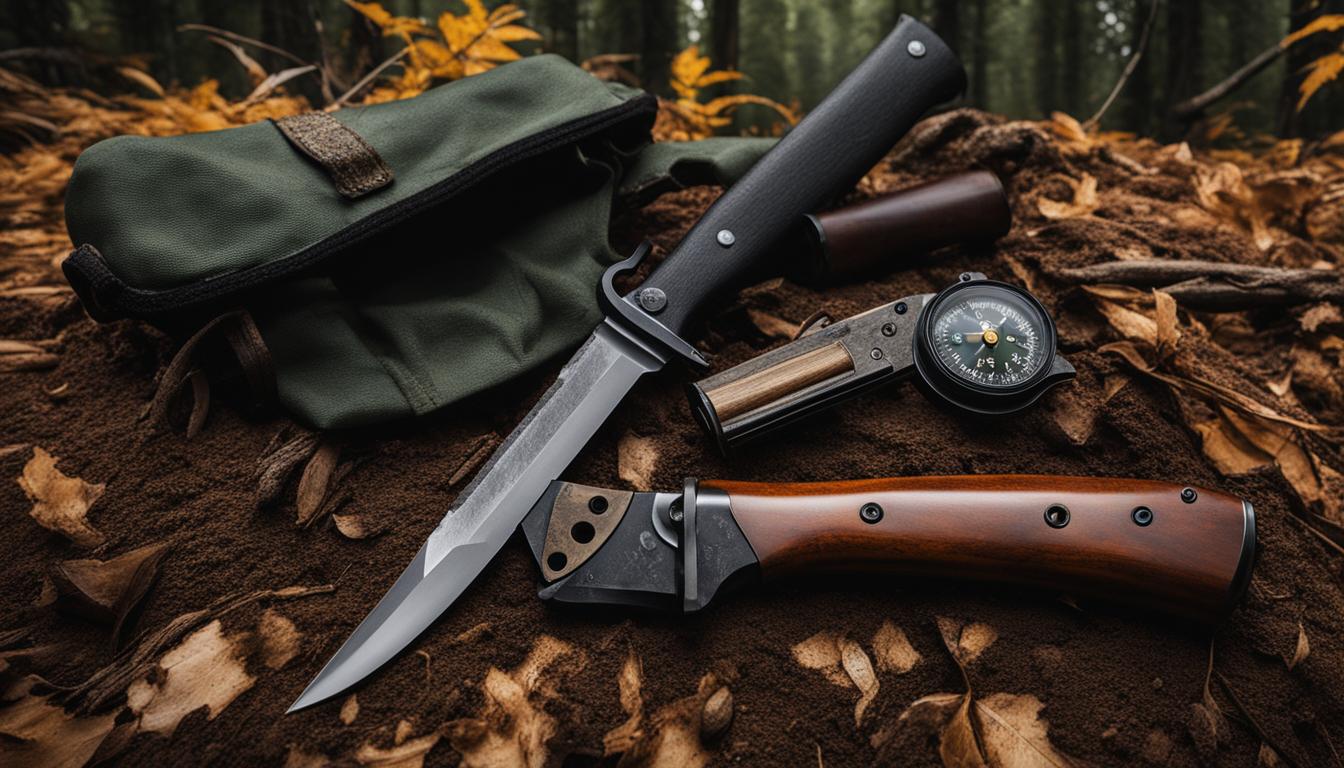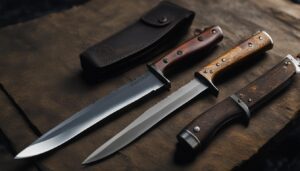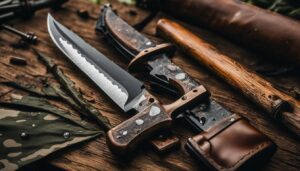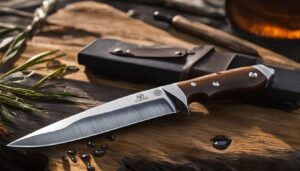When it comes to hunting knives, rust can be a major issue. Steel, including both carbon steel and stainless steel, is susceptible to rust. However, there are ways to prevent rust and protect your hunting knives. In this guide, we will explore the different types of rust protection available for hunting knives and provide tips on how to keep your knives rust-free.
Key Takeaways:
- Rust is a major concern for hunting knives made of carbon steel or stainless steel.
- Proper care and maintenance are essential for preventing rust on hunting knives.
- Different types of blade finishes offer varying levels of rust protection.
- Damascus steel hunting knives require special consideration for rust protection.
- Choosing the best blade finish depends on durability, corrosion resistance, and personal preference.
Understanding Rust and Knife Patina
Rust is a common problem that can affect the performance and longevity of hunting knives. It is important to understand the causes of rust in order to effectively protect your knives. Rust occurs when the iron in steel reacts with oxygen and water, resulting in a reddish-brown buildup. This corrosive process can damage the blade if left untreated.
It is worth noting that while stainless steel is more resistant to rust than carbon steel, it is not completely immune. Stainless steel contains a higher percentage of chromium, which forms a thin layer of oxide on the surface, providing some protection against corrosion. However, prolonged exposure to moisture and harsh conditions can still lead to rust formation.
On the other hand, knife patina is a natural protective layer that forms on the surface of carbon steel blades. This yellowish color develops over time through exposure to air, moisture, and other substances. Unlike rust, patina actually acts as a barrier, preventing further corrosion and protecting the blade. Many hunters appreciate the unique appearance that a well-developed patina adds to their knives.
Quote: “Rust is a common enemy of hunting knives, but understanding the difference between rust and patina is crucial for maintaining blade integrity.” – Knife Expert
By understanding the nature of rust and patina, you can take proactive measures to protect your hunting knives. Whether it’s through regular cleaning, applying a protective coating, or choosing the right blade material for your specific needs, preventing rust and nurturing the development of a patina are essential steps in maintaining the performance and durability of your hunting knives.
| Rust | Patina |
|---|---|
| Reddish-brown buildup | Yellowish color |
| Destructive corrosion | Natural protective layer |
| Occurs when iron in steel reacts with oxygen and water | Develops through exposure to air, moisture, and substances |
| Can cause blade damage if left untreated | Acts as a barrier, protecting the blade |
How to Prevent Rust on Hunting Knives
When it comes to preserving the quality and performance of your hunting knives, rust prevention is of utmost importance. Here are some essential tips to help you keep your knives rust-free:
- Keep your knives clean and dry: After each use, make sure to clean your knives thoroughly with warm, soapy water. Dry them immediately and ensure there is no moisture left on the blade or handle. Moisture left on the knife can accelerate rust formation.
- Apply a protective coating: Utilize a rust prevention product specifically designed for knives, such as a food-grade mineral oil or a silicone-based preservative. Apply a thin coat of the protective coating to all metal parts of the knife, including the blade, bolster, and tang.
- Store your knives properly: To prevent rust, store your knives in a dry environment with low humidity. Consider using a knife sheath, a knife block, or a knife roll to protect them from dust, moisture, and physical damage.
- Regularly inspect and maintain your knives: Take the time to inspect your knives regularly for any signs of rust or corrosion. If you notice any spots, immediately clean and treat them with a rust remover or fine steel wool. Remember to reapply the protective coating after cleaning.
By following these rust prevention tips, you can ensure that your hunting knives stay in optimal condition, ready for your next outdoor adventure.
Testimonials
“I’ve been hunting for years, and rust has always been a concern for me. Since I started following these rust prevention tips, I haven’t had any issues with rust on my knives. It’s made a significant difference in the longevity and performance of my blades.”
– Mark Thompson, avid hunter
Recommended Products
| Product | Description | Price |
|---|---|---|
| Kershaw Knife Oil | A high-quality knife oil that provides long-lasting rust protection. It is easy to apply and helps keep knives in top condition. | $9.99 |
| Eezox Premium Gun Care | A versatile rust preventative that works well for hunting knives. It leaves a thin, dry film on the blade, providing excellent protection against moisture and corrosion. | $14.99 |
| Birchwood Casey Barricade Rust Protection | An affordable rust protection spray that effectively prevents rust and corrosion. It leaves a thin film that seals out moisture and protects the knife’s metal surfaces. | $7.99 |
Remember, regular maintenance and proper care go a long way in preventing rust on your hunting knives. By implementing these tips and using the recommended products, you can ensure that your knives remain in excellent condition for years to come.
Different Types of Blade Finishes for Rust Protection
When it comes to choosing the best rust protection for your hunting knives, the type of blade finish you select plays a crucial role. Different blade finishes offer varying degrees of resistance to corrosion and require different levels of maintenance. Let’s explore some popular blade finishes and their rust protection capabilities:
Mirror Polish Finish
A mirror polish finish is highly reflective and gives your hunting knife a sleek and stylish appearance. It offers good resistance to corrosion and is relatively easy to clean. However, keep in mind that a mirror polish finish may show scratches more easily, so it may require extra care to maintain its pristine look.
Polished Finish
Similar to a mirror polish finish, a polished finish provides good corrosion resistance and requires regular cleaning to keep your hunting knife rust-free. It has a shiny appearance but is not as highly reflective as a mirror polish finish. Polished finishes strike a balance between aesthetics and rust protection.
Stonewashed Finish
A stonewashed finish has a matte appearance and is achieved by tumbling the blade with small abrasive material. This finish not only gives your hunting knife a rugged and worn look but also provides better scratch resistance. However, a stonewashed finish may require more frequent maintenance to prevent rust formation.
Bead-Blasted Finish
A bead-blasted finish is achieved by blasting the blade with small glass beads, which results in a uniform matte appearance. This finish offers good resistance to corrosion and is more scratch-resistant compared to mirror polish and polished finishes. However, like a stonewashed finish, it may need regular maintenance to prevent rust.
When selecting the best blade finish for rust protection, consider the level of maintenance you are willing to undertake, the desired appearance of your hunting knife, and the overall durability and corrosion resistance of the finish. Each type of blade finish has its own unique qualities and benefits, so choose the one that best suits your needs and preferences.
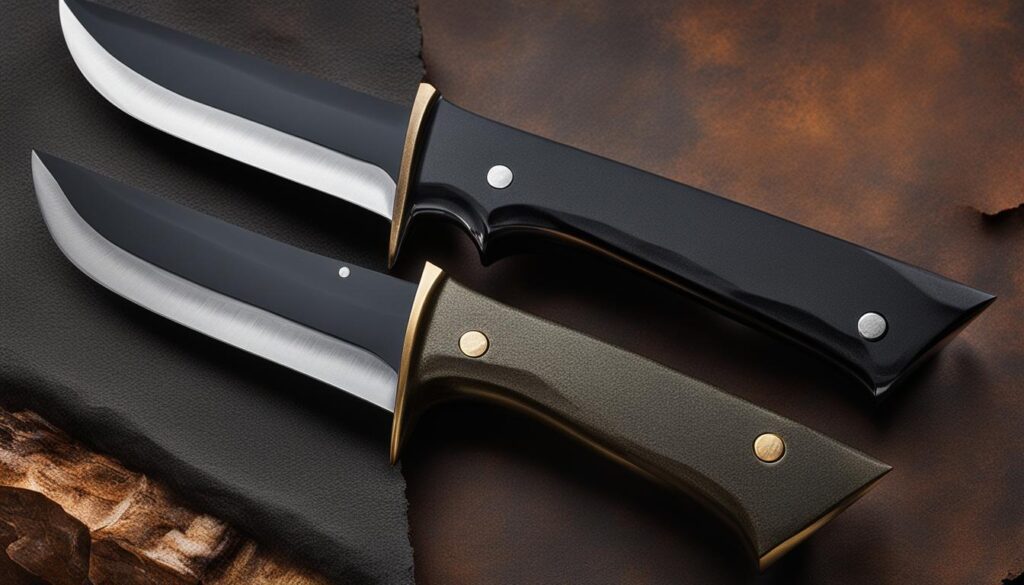
| Blade Finish | Rust Protection | Scratch Resistance | Maintenance |
|---|---|---|---|
| Mirror Polish | Good | May show scratches easily | Regular cleaning |
| Polished | Good | Less reflective | Regular cleaning |
| Stonewashed | Moderate | Better scratch resistance | Regular maintenance |
| Bead-Blasted | Good | More scratch-resistant | Regular maintenance |
Factors Affecting Rust Formation in Damascus Steel
Damascus steel is renowned for its beauty and strength, but it is important to understand that it is not immune to rust. Several factors can impact the rust resistance of Damascus steel, and being aware of these factors is crucial in selecting the right rust protection for your Damascus steel hunting knives.
Exposure to moisture and air is one of the primary factors that can lead to rust formation in Damascus steel. When a knife is exposed to these elements for prolonged periods, the moisture can react with the iron in the steel, causing oxidation and rusting. Additionally, improper storage or handling practices that expose the blade to moisture can accelerate rust formation.
The composition of the steel itself also plays a role in its rust resistance. Damascus steel is a combination of different types of steel, typically high-carbon steel and softer alloyed steel. The presence of impurities or contaminants in the steel can affect its ability to resist rust and corrosion. Therefore, it is essential to choose Damascus steel that is made from high-quality materials and has been properly forged and treated to maximize its rust resistance.
“The composition of the steel itself also plays a role in its rust resistance.”
Other factors that can contribute to rust formation in Damascus steel include exposure to harsh chemicals, extreme temperatures, and a lack of regular cleaning and maintenance. Chemicals such as acids or alkaline solutions can corrode the steel and weaken its resistance to rust. Extreme temperatures, particularly high humidity or freezing conditions, can also promote rust formation. Neglecting regular cleaning and maintenance practices can allow dirt, debris, and moisture to accumulate on the blade, increasing the risk of rust.
By considering these factors and implementing proper care and maintenance practices, you can enhance the rust resistance of your Damascus steel hunting knives. Regularly clean and dry your knives after use, store them in a dry and controlled environment, and consider applying a rust-inhibiting coating or wax to provide an additional layer of protection against rust formation.
| Factors affecting rust formation in Damascus steel |
|---|
| Exposure to moisture and air |
| Improper storage or handling |
| Composition of the steel |
| Presence of impurities or contaminants |
| Exposure to harsh chemicals |
| Extreme temperatures |
| Lack of regular cleaning and maintenance |
Understanding and addressing these factors will help ensure that your Damascus steel hunting knives remain rust-free and maintain their exceptional performance and longevity.
Choosing the Best Blade Finish for Rust Protection
When it comes to protecting your hunting knives from rust, choosing the right blade finish is crucial. The right finish not only enhances the knife’s appearance but also provides an added layer of protection against corrosion. Here, I will discuss the best blade finishes for rust protection and highlight their unique benefits.
Mirror Polish
One of the most popular blade finishes for rust protection is the mirror polish. This finish not only gives the knife a sleek and sophisticated look but also offers excellent resistance to corrosion. The highly reflective surface of the mirror polish finish prevents moisture and contaminants from coming into direct contact with the steel, thus reducing the chances of rust formation. However, it’s worth noting that mirror polish finishes may show scratches more easily, requiring careful maintenance to keep them in pristine condition.
Stonewashed
If you’re looking for a blade finish that combines rust resistance with a rugged appearance, stonewashed finishes are an excellent choice. With their matte appearance and textured surface, stonewashed finishes offer good scratch resistance and hide any wear and tear that may occur over time. While they may require regular maintenance to prevent rust, stonewashed finishes provide a unique aesthetic that many hunters appreciate.
Bead-Blasted
Another popular choice for rust protection is the bead-blasted finish. This finish gives the blade a uniform matte appearance and enhances its resistance to both rust and scratches. The bead-blasting process involves shooting small glass beads at the steel surface, creating a textured finish that not only looks great but also helps prevent rust formation. However, it’s important to note that bead-blasted finishes may require occasional oiling or waxing to maintain their rust-resistant properties.
| Blade Finish | Benefits |
|---|---|
| Mirror Polish | Excellent resistance to corrosion |
| Stonewashed | Good scratch resistance and rugged appearance |
| Bead-Blasted | Uniform matte appearance and enhanced rust resistance |
Ultimately, the best blade finish for rust protection depends on your personal preferences and the intended use of the knife. Whether you prioritize a sleek and glossy look or prefer a more textured and rugged appearance, there is a blade finish that suits your needs. Just remember to consider the level of maintenance required for each finish to ensure optimal rust protection for your hunting knives.
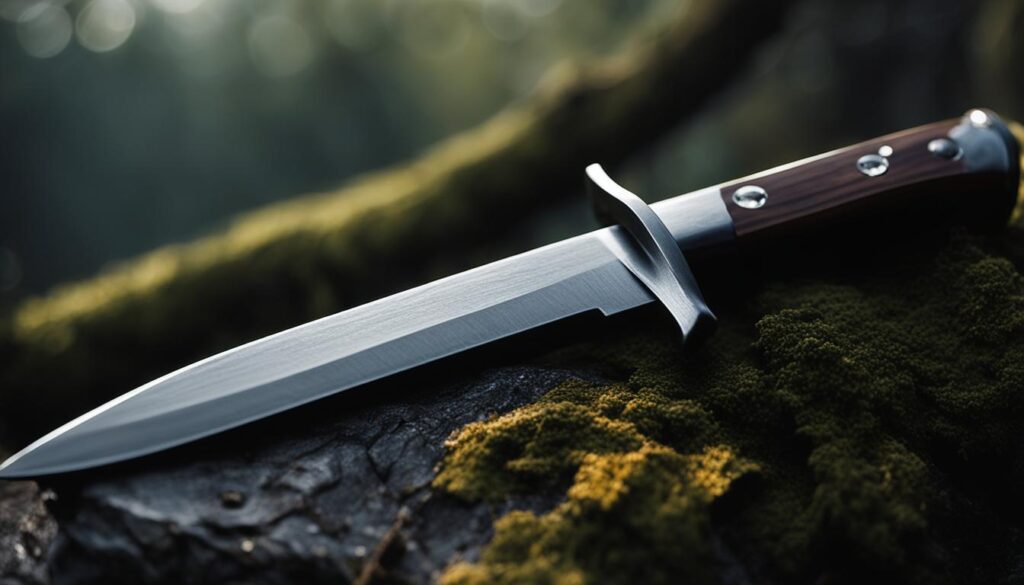

Conclusion
In conclusion, rust protection is crucial for maintaining the longevity and performance of hunting knives. Rust can be a major issue for both carbon steel and stainless steel blades, but there are ways to prevent rust and protect your knives.
Proper care and maintenance are essential to prevent rust on your hunting knives. Regular cleaning, waxing, and choosing the right blade finish can all contribute to rust prevention. By understanding the factors that contribute to rust formation, such as exposure to moisture and air, improper storage, and lack of regular cleaning, hunters can take preventive measures to keep their knives rust-free.
Investing in rust protection for your hunting knives is a wise choice to preserve their sharpness and reliability throughout your hunting adventures. Whether it’s selecting a specific blade finish, implementing a regular maintenance routine, or seeking professional rust prevention solutions, protecting your knives from rust will extend their lifespan and ensure optimal performance in the field.
FAQ
Can stainless steel hunting knives rust?
Yes, stainless steel can rust, although it takes longer than carbon steel.
What is the difference between rust and a patina on a knife blade?
Rust is a reddish-brown buildup that occurs when iron in steel reacts with oxygen and water, while a patina is a yellowish color that develops on the surface of a carbon steel blade through exposure to air, moisture, and other substances. Unlike rust, a patina actually protects the blade from corrosion.
How can I prevent rust on my hunting knives?
Proper care and maintenance are essential. Keep your knives clean, dry, and regularly oiled. Avoid leaving them in wet or humid environments.
What factors affect the rust resistance of Damascus steel hunting knives?
Several factors can affect the rust resistance of Damascus steel, including exposure to moisture and air, improper storage or handling, the composition of the steel, the presence of contaminants or impurities, exposure to harsh chemicals, extreme temperatures, and lack of regular cleaning and maintenance.
Which blade finish offers better rust protection?
Mirror polish and polished finishes offer good resistance to corrosion, while stonewashed and bead-blasted finishes provide better scratch resistance. The best blade finish will depend on personal preference and the intended use of the knife.
